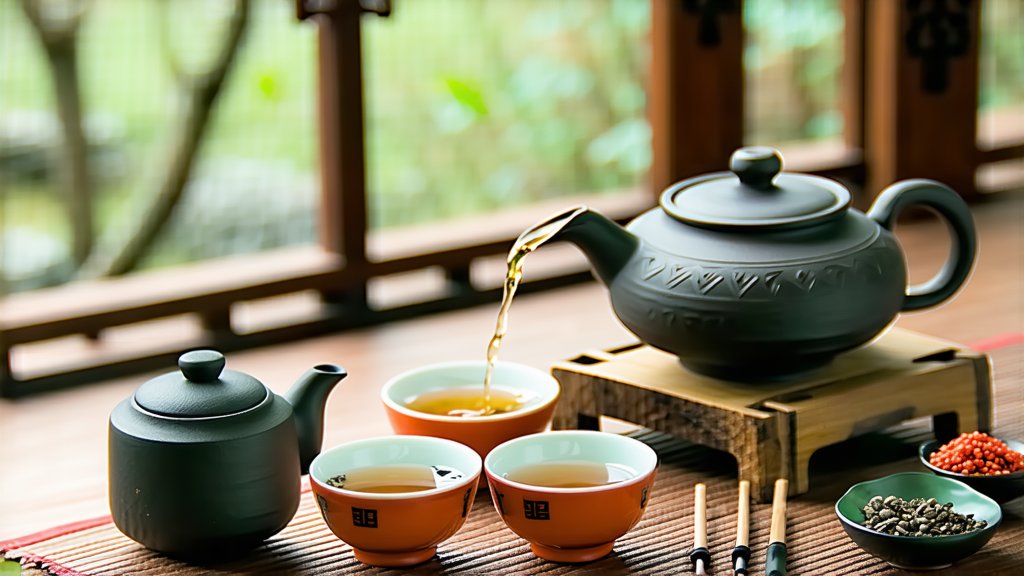
Liu Bao tea, a distinguished member of the revered Chinese black tea family known as "Hei Cha," stands as a testament to the rich tapestry of Chinese tea culture and its enduring legacy. This unique variety, hailing from the Guangxi province, has captivated tea enthusiasts worldwide with its complex flavors, medicinal properties, and the fascinating transformation it undergoes over time. In this exploration, we delve into the historical roots, diverse types, intricate production methods, and the art of appreciating Liu Bao tea.
Historical Background
The origins of Liu Bao tea can be traced back to the early Qing Dynasty, around the 17th century. It was during this period that tea merchants discovered the unique aging process that occurs when green tea leaves are stored in the humid climate of the Guangxi region. Over time, these teas transformed into a dark, earthy brew with unparalleled depth and character, earning them the name "Liu Bao," meaning "Six堡" or "Six Forts," referring to the six fortified warehouses where they were traditionally aged.
Varieties of Liu Bao Tea
Liu Bao tea encompasses a broad spectrum of styles, each offering a distinct sensory experience. The primary classifications include raw (Sheng) and ripe (Shou), reflecting different processing techniques and aging potentials:
-
Raw Liu Bao (Sheng Liu Bao): Made from sun-dried green tea leaves, Sheng Liu Bao retains more of its original characteristics, including a brighter flavor profile and greater potential for long-term aging. As it matures, it develops deeper, more complex notes reminiscent of forests, fruits, and spices.
-
Ripe Liu Bao (Shou Liu Bao): This type undergoes a post-fermentation process called "wo dui," which accelerates the aging process through controlled humidity and temperature conditions. Shou Liu Bao is known for its mellow, earthy taste with hints of wood, dried fruit, and a smooth, velvety texture.
The Art of Liu Bao Tea Production
The creation of Liu Bao tea is an art form that combines tradition, skill, and patience. Here's a glimpse into its meticulous production process:
-
Harvesting: High-quality tea leaves are handpicked during specific seasons, typically spring and autumn, ensuring optimal freshness and flavor.
-
Fixation: Fresh leaves are quickly heated to halt oxidation, preserving their vibrant green color and natural aromas.
-
Rolling: The leaves are rolled to release juices and shape them into twisted strands.
-
Fermentation (for Sheng Liu Bao): For raw Liu Bao, the leaves are left to age naturally in bamboo baskets or clay pots, allowing microbial activity and enzymatic reactions to gradually transform their flavor profile over years or even decades.
-
Post-Fermentation (for Shou Liu Bao): In contrast, Shou Liu Bao undergoes the wo dui process, where piles of tea are moistened and turned regularly to encourage microbial growth and accelerate aging. This can take several months to a few years.
-
Drying & Packaging: Once the desired maturity is achieved, the tea is dried and packaged in breathable materials like hemp cloth or bamboo baskets for continued aging or immediate consumption.
The Tea Tasting Ritual
To fully appreciate Liu Bao tea, one must engage in the ritualistic practice of Gongfu Cha, or "Kung Fu Tea." This involves precision in measurement, temperature control, and multiple short steepings to extract the nuanced flavors from the tightly rolled leaves. Here’s a guide to savoring Liu Bao:
-
Preparation: Use a Yixing clay teapot or a Gaiwan, preferably unglazed, to enhance the tea's aroma. Rinse the teaware with hot water to warm them up.
-
Measuring: Take approximately 5 grams of Liu Bao tea per 100ml of water capacity. For aged teas, slightly less may be used due to their concentrated flavors.
-
Steeping: Boil water to around 95°C (203°F) for Sheng Liu Bao and slightly cooler for Shou Liu Bao. Pour water over the tea and immediately decant to avoid over-extraction. Steep times vary but generally start at 10-15 seconds for the first infusion, increasing incrementally with each subsequent brew.
-
Aroma & Taste: Before sipping, inhale deeply to appreciate the evolving aromas. Sip slowly, allowing the tea to coat your palate, noting the balance between sweetness, bitterness, and umami. Pay attention to the aftertaste and how it lingers on your tongue.
-
Multiple Infusions: Liu Bao tea is renowned for its ability to be steeped multiple times, each infusion revealing new dimensions of flavor. Enjoy this journey as the tea unfolds its story across successive cups.
In conclusion, Liu Bao tea is not just a beverage; it's a cultural treasure that embodies the harmony between nature, craftsmanship, and time. Its history spans centuries, its varieties offer a spectrum of experiences, and its production is a testament to the artistry and patience inherent in traditional Chinese tea making. By engaging in the ritual of tasting Liu Bao tea, one embarks on a sensory adventure that transcends borders and connects us to the profound wisdom of ancient tea traditions.